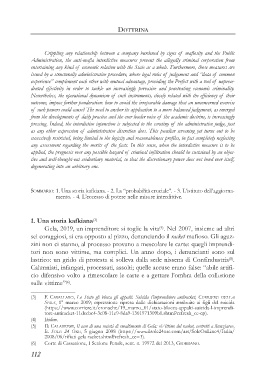Page 114 - Rassegna 2019-2
P. 114
DOTTRINA
Crippling any relationship between a company burdened by signs of mafiosity and the Public
Administration, the anti-mafia interdictive measures prevent the allegedly criminal corporation from
entertaining any kind of economic relation with the State as a whole. Furthermore, those measures are
issued by a structurally administrative procedure, where legal rules of judgement and “data of common
experience” complement each other with mutual advantage, providing the Prefect with a tool of unprece-
dented effectivity in order to tackle an increasingly pervasive and penetrating economic criminality.
Nevertheless, the operational dynamism of such instruments, closely related with the efficiency of their
outcome, impose further ponderation: how to avoid the irreparable damage that an unconcerned exercise
of such powers could cause? The need to anchor its application to a more balanced judgement, as emerged
from the developments of daily practice and the ever louder voice of the academic doctrine, is increasingly
pressing. Indeed, the interdictive injunction is subjected to the scrutiny of the administrative judge, just
as any other expression of administrative discretion does. This peculiar screening yet turns out to be
excessively restricted, being limited to the logicity and reasonableness profiles, in fact completely neglecting
any assessment regarding the merits of the facts. In this sense, when the interdictive measure is to be
applied, the prognosis over any possible hazard of criminal infiltration should be sustained by an objec-
tive and well-thought-out evidentiary material, so that the discretionary power does not bend over itself,
degenerating into an arbitrary one.
SOMMARIO: 1. Una storia kafkiana. - 2. La “probabilità cruciale”. - 3. L’istituto dell’aggiorna-
mento. - 4. L’eccesso di potere nelle misure interdittive.
1. Una storia kafkiana
(3)
Gela, 2019, un imprenditore si toglie la vita . Nel 2007, insieme ad altri
(4)
sei coraggiosi, si era opposto al pizzo, denunciando il racket mafioso. Gli aguz-
zini non ci stanno, al processo provano a mescolare le carte: quegli imprendi-
tori non sono vittime, ma complici. Un anno dopo, i denuncianti sono sul
lastrico: un grido di protesta si solleva dalla sede nissena di Confindustria .
(5)
Calunniati, infangati, processati, assolti; quelle accuse erano false: “abile artifi-
cio difensivo volto a rimescolare le carte e a gettare l’ombra della collusione
sulle vittime” .
(6)
(3) F. CAVALLARO, Lo Stato gli blocca gli appalti. Suicida l’imprenditore antiracket, CORRIERE DELLA
SERA, 1° marzo 2019; espressione ripresa dalle dichiarazioni attribuite ai figli del suicida
(https://www.corriere.it/cronache/19_marzo_01/stato-blocca-appalti-suicida-l-imprendi-
tore-antiracket-11decbc4-3c08-11e9-8da9-1361971309b1.shtml?refresh_ce-cp).
(4) Ibidem.
(5) D. CALABRESE, Il caso di una società di smaltimento di Gela: «Vittime del racket, costretti a licenziare»,
IL SOLE 24 ORE, 5 giugno 2008 (https://www.ilsole24ore.com/art/SoleOnLine4/Italia/
2008/06/rifiuti-gela-racket.shtml?refresh_ce=1).
(6) Corte di Cassazione, I Sezione Penale, sent. n. 19972 del 2013, GIORDANO.
112

